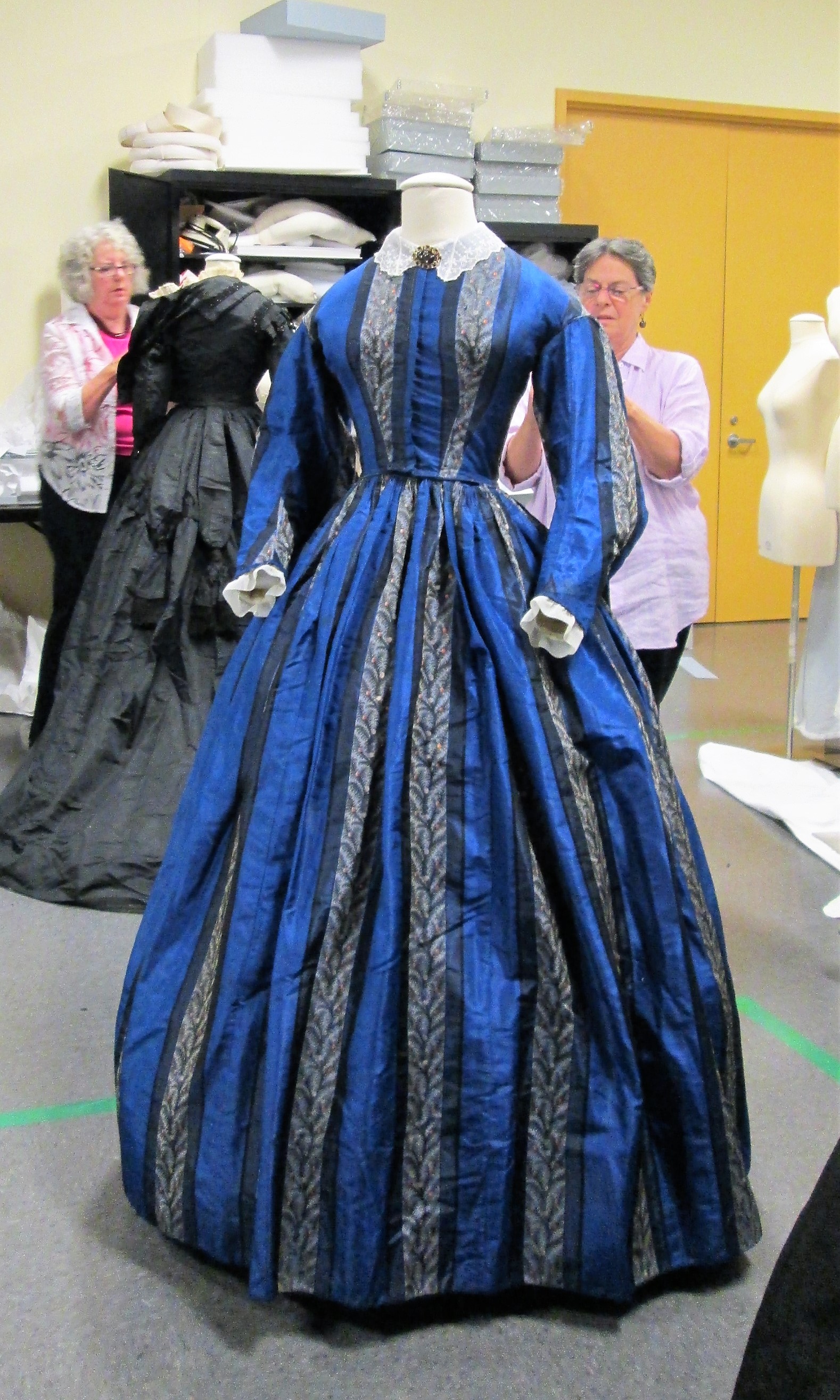Am I Blue?
A Civil War Era Dress Is Readied For Display.
by Norah Worthington, Fashion Archives Intern, Summer 2018

This lovely sapphire silk striped dress was selected to go on display in our “Divided Voices: Maryland in the Civil War” exhibition. On first inspection it looked quite well prepared, but after a more thorough examination, it seemed best to stabilize a few areas showing stress before mounting it on a form. And down the rabbit hole we went.
 |
|
Black bias tape stabilizes the waist from the inside; top part of the picture shows the inside of the cartridge pleated skirt
Women’s Blue Day Dress, circa 1862, silk, Maryland Historical Society,
Gift of Mr. J. Richard Wilkins, 1977.103.5
|
Conservation in preparation for display is always a balancing act. How much time can we afford and what is most critical or what can wait for a later date? We began by deciding to support the frayed areas of the neck by backing with bias tape and darning the remaining bodice threads with hair silk (yes, it’s as thin as it sounds, get out your best magnifiers). That seemed straightforward enough, but then the waist of the bodice was showing the same kind of stress.Bias tape backing to the rescue, again. And then the metal loop on the center front required a strip of twill tape to keep it in place against the shattered glazed cotton lining that was deteriorating moment by moment.
 |
|
Inside view of the bodice showing shattered glazed cotton lining and cream interior padding
Women’s Blue Day Dress, circa 1862, silk, Maryland Historical Society,
Gift of Mr. J. Richard Wilkins, 1977.103.5
|
Ready for the dress form? Well, actually, those civil war era bust pads seen above needed some netting to keep them in place before mounting on the form. And the worn spots on the wool tape along the skirt hem could use a little mending with thread. (We would like to remove the tape entirely and turn it so the good side was showing around the entire circumference of the hem, but that would have to wait until another day.) We added a collar, brooch, sleeve ruffles, hoop and petticoat, and the dress was ready to go in the case.
 |
|
Newbie Richardson prepares dress for the Civil War Gallery
Women’s Blue Day Dress, circa 1862, silk, Maryland Historical Society,
Gift of Mr. J. Richard Wilkins, 1977.103.5
|
But while I was working so intimately with this object, I was able to notice a few things I might have otherwise missed. There is a double row of piping around the bodice waist. There is a charming watch pocket on the left front at the waist(as well as a pocket slit on the right front disguised in the skirt). The skirt seams are sewn by hand. (Is this a remade dress from the 1850’s? There is significant piecing on the bodice and sleeves.) There is a loop at the center of the back at the skirt waist (perhaps for hanging?). The stripe down the center of the back of the bodice is not quite centered (it wasn’t all perfection in the past). The bust pads go all the way to the underarm and acted as dress shields, which helped to preserve the silk from sweat. As I whip-stitched the bias tape to the inside binding of the neck edge, I noticed the shoulder seam allowances were whipped together. In the meditation that is handwork, I sent a thought back to the dressmaker, or makers, that made this dress: I see your work, it is lovely, and this sapphire blue gown is ready to be enjoyed again.
 |
|
Watch pocket on left front waist of skirt
Women’s Blue Day Dress, circa 1862, silk, Maryland Historical Society,
Gift of Mr. J. Richard Wilkins, 1977.103.5
|
 |
|
Inside view of pale blue cotton watch pocket
Women’s Blue Day Dress, circa 1862, silk, Maryland Historical Society,
Gift of Mr. J. Richard Wilkins, 1977.103.5
|
To see the stunning silks for yourself and the rest of the re-configured installation, including a woman’s mourning dress never before on display, visit the Divided Voices: Maryland in the Civil War exhibition, recently redesigned and reopened in summer 2018.
New Call-to-action

